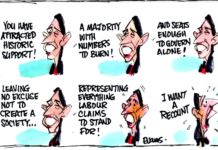Money creation by the Reserve Bank has been rightly blamed for contributing to our high inflation rate, but this is because the money has gone to the wrong sector of our economy.
Through quantitative easing (also known as Large Scale Asset Purchases or LSAP) the Reserve Bank created $55 billion and pumped it into an overstimulated financial market.
Surprise, surprise the cost of housing and other assets took off, along with banks’ profits. As the housing market was already overstimulated, the new money contributed to about one-third of the increase in annual inflation.
This was not a good way to use the newly-created money if the Reserve Bank was to fulfil its mission, “to enable economic wellbeing and prosperity for all New Zealanders”.
The Government also provided a $30 billion line of credit to the banks to lend to individuals and businesses. The intention was for the banks to provide stimulus to the real economy. The predictable problem was that businesses were reluctant to take on additional debt in times of uncertainty.
Add to that the banks could make more profit from the housing market and unless businesses could put housing as collateral, most missed out. Again, poor use of money creation by our Reserve Bank.
A wiser use of money creation would be for the Reserve Bank to provide it for infrastructure projects to fix our failing roads, schools, hospitals and three waters.
This option has been referred to as Direct Monetary Financing or Quantitative Easing for the People. Some pundits say it will be inflationary, but a Levy Institute paper titled, “Is Monetary Financing Inflationary? A Case Study of the Canadian Economy, 1935–75” found no support for a relationship between direct monetary financing and inflation.
For forty years the Canadian Central Bank funded the construction of highways, airports, bridges, schools, hospitals, and other infrastructure with little or no impact on inflation.
Our own Reserve Bank used a similar approach to fund the construction of thousands of state houses in the 1930s which helped bring New Zealand out of the Great Depression.
Our Reserve Bank should stop providing money to our privately owned banks and put the money to work for the benefit of all New Zealanders. We also face a bigger bill in the form of climate change remediation. Direct Monetary Financing will enable us to meet this threat without saddling future generations with a mountain of debt.
Don Richards, National Spokesperson for Positive Money New Zealand
About Positive Money
Positive Money NZ is an independent, non-profit group advocating for monetary reform in New Zealand. Our patron is Bryan Gould, and we are part of a global movement of organisations, the International Movement for Monetary Reform, campaigning to change the way money is created so that money serves society.






Has our finance minister been warned by those who have international control of money and finance of some kind of serious consequences to our financial security as a country if we try to bypass the banks and use direct monetary financing.
It seems to me that we are all pretending that money exists anyway so why not pretend it exists independent of the private banking system.
You have a broken link for the Levy Institute paper on Canada. Here is one that works: https://www.levyinstitute.org/pubs/wp_848.pdf
The wealthy has done extremely well out of the current Government money management
Acronyms can form word pictures in our brains.
That’s why it’s called LSAP not LAPS – Large Asset Purchase Scale – (has rational meaning.)
Through quantitative easing (also known as Large Scale Asset Purchases or LSAP) the Reserve Bank created $55 billion and pumped it into an overstimulated financial market.
Then there is MBIE, not including the vowel which would be natural for ease of speech – making it MOBIE; too much like the name of the giant Brobdingnagian sought endlessly by obsessional humans.
Interestingly, and depressingly, you never mentioned agriculture aka agrarian pastimes etc, as being that which earns the mighty money that comes back into AO/NZ after those exports-currencies are received once the shipping, distribution and consumption of those agrarian goods, to our offshore consumers, has been done. I must ask. Why is that? By not recognizing the very zenith of the creation of AO/NZ’s economy you leave a gaping hole in support of your opinions and I’m sorry to say, and as a result of that, I have no respect for your opinions because of that glaring oversight on your part.
“Positive Money NZ is an independent, non-profit group advocating for monetary reform in New Zealand.”
Is it. And yet you make no mention from where AO/NZ’s money originates. That must make your independent and non profit job bloody difficult if not impossible. What do you work with? Fairy incantations? Runes? Prunes?
A logical fallacy, false narrative being squeezed out of an all bought and paid for MSM to act as a miasma for the rugby, racing and beer brigade?
Here’s what you do. Follow the money from AFTER the farm gate to the dinner plate. Follow the money from the triple dumped wools and frozen meats to Europe, Britain and sundry northern hemisphere markets. See where that money goes, see where it idles and see who finds it there, all by its lonely little self.
Are we affected in dairy, by hedging prices as cocoa may be?
https://www.foodcircle.com/magazine/cocoa-pricing-commodity-market
Lots of fingers in the pie, makes for complexity.
https://www.icco.org/trading-shipping/
Just thinking.
I do agree with this article in theory but the hype of the property market is taking far too long to die down and is far too lucrative for the banks. Until our economy starts to recede, which I personally believe will be in July of next year, we’re stuck with the status quo unfortunately.